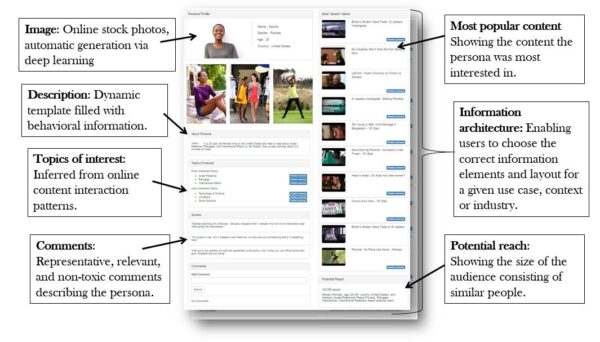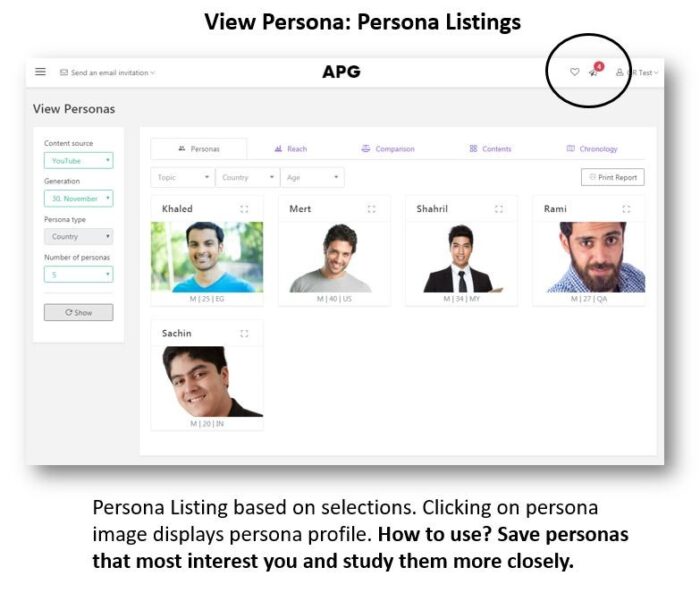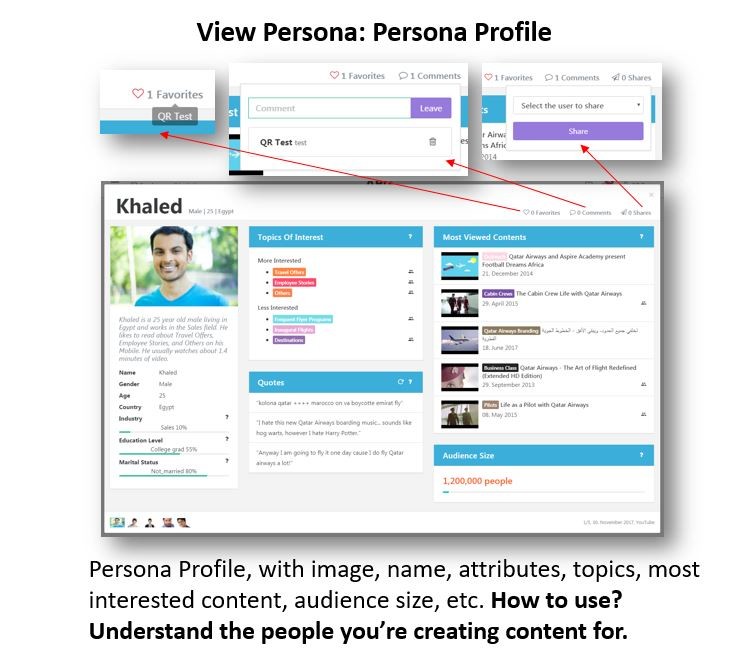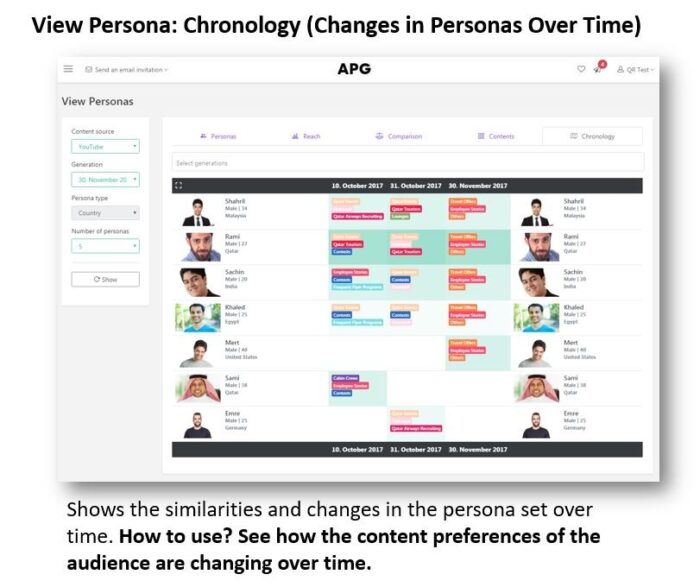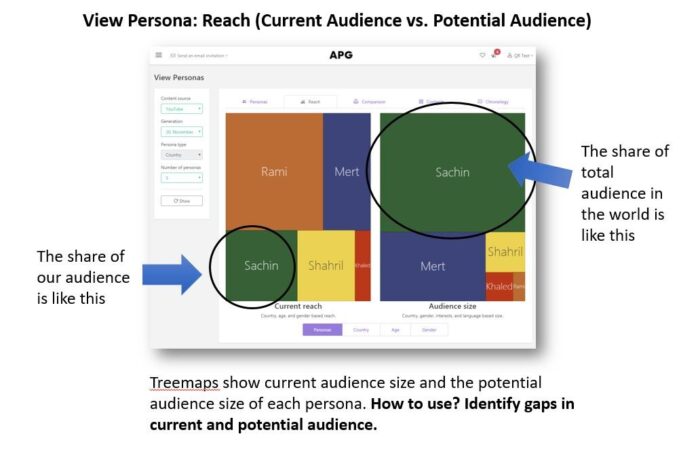Last updated on May 5, 2020
This is a joint piece by Dr. Joni Salminen and Professor Jim Jansen. The authors are working on a system for automatic persona generation at the Qatar Computing Research Institute. The system is available online at https://persona.qcri.org.
Introduction
Personas are fictive characterizations of the core audience or customers of a company, introduced into software development and marketing in the 1990s (see Jenkinson, 1994; Cooper, 1999). Personas capture and summarize key elements of key customer segments so that decision makers could better understand their audience or customers, not just by using numbers but also referring to qualitative attributes, such as key pain points and desires, needs and wants.
Out team refers to persona creation as “giving faces to data,” as personas are ideally based on real data on customer behavior.
Figure 1 shows an example of a data-driven persona in which the attributes are inferred automatically from social media data.
Figure 1: Data-driven persona.
While personas have been argued to have many benefits in the academic literature (see e.g., Nielsen, 2004; Pruitt & Grudin, 2003; Salminen et al., 2017), we are constantly facing the same questions from new client organizations wishing to use our system for automatic persona generation (APG) (An et al., 2017).
Namely, they want to know how to use personas in practice. While we often make the analogy that personas are like any other analytics system, meaning that the use cases depend on the client’s information needs (i.e., what they want to know about the customers), this answer is still a bit puzzling to them.
For that reason, we decided to write this piece outlining some key use cases for personas. These are meant as examples, as the full range of use cases is much wider.
We will first explore some general use cases, and then proceed to elaborate on more specific persona use cases by different organizational units.
General Use Cases of Personas
In general, there are three main purposes personas serve:
1) Customer Insights. This deals with getting to know your core audience, users or customers better. For example, APG enables an organization to understand its audience’s topics of interest and preferred social media content. Who uses? Everyone in the organization.
2) Creation Activities. Using persona information to create better products, content, marketing communication, or other outputs. Who uses? Everyone in the organization dealing with customer-facing outputs.
3) Communication. Using personas for communication across departments. While it is difficult to discuss a spreadsheet, it is much easier to communicate about a person. Sharing the persona work across divisions thus increases the chance for realization of benefits. Personas make data communicable and keep team members focused on the customer needs. Who uses? Everyone in the organization.
Specific Use Cases of Personas
In addition to shared use cases of personas, there are more specific use cases. For example, product managers can use the information to design a product that meets the needs or desires of core customers, and marketing can use personas to craft messages that resonate. Here, we are outlining specific examples of use cases within organizational units. More specifically, we allocate these use cases under four sections.
1) Customer Insights and Reporting
Journey Mapping: Plot the stages and paths of the persona lifecycle, documenting each persona’s unique state of mind, needs and concerns at each stage. Understand your website visitors’ customer journey.
Persona Discovery: Document the individuals involved in the purchase process in a way that allows decision makers to empathize with them in a consistent way.
Brand Discovery: Uncover how your core customers feel about your product or service and how they rationalize their purchase decisions.
Reporting and Feedback: Report and review data and insights to drive strategic decisions, as well as provide information to the organization as a whole.
2) Creation Activities
Planning Product Offerings: With the help of personas, organizations can more easily build the features that suit their customers’ needs. Consider the goals, desires, and limitations of core customers to guide feature, interface, and design choices.
Role Playing: Personas help product developers “get into character” and understand the circumstances of their users. They facilitate genuine understanding of the thoughts, feelings, and behaviors of core customers. Individuals have a natural tendency to relate to other humans, and it’s important to tap into this trait when making design and product development choices.
Content Creation: Content creators can leverage personas for delivery of content that will be most relevant and useful to their audience. When planning for content, we might ask “Would Jamal understand this?” or “Would Jamal be attracted by this?”
Personas help one determine what kind of content is needed to resonate with core customers and in which tone or style to deliver the content. Naturally, customer analytics can and should be used to verify the results.
3) Persona Experimentation
Channel and Offering Alignment: Align every piece of offerings and marketing activity to a persona and purchase stage, identifying new channels and needs where opportunities exist.
Prediction of Popularity: Predict how a given persona will react to content, marketing messages, or products. This is a particular advantage of data-driven personas that enable using the underlying topical interests of the persona to model the likely match between personas and a given content unit.
Experimentation and Optimization: Carry out well-thought experiments with personas to produce statistically valid business insights and apply the results to optimize performance. For example, you could run Facebook Ads campaigns targeting segments corresponding to the core personas and analyze whether the campaigns perform better than broader or other customer segments.
4) Strategic Decision Making
Strategic Marketing: When you understand where your core customers spend their time online, you are able to focus your marketing spend on these channels. For example, if the data shows that your core customers prefer YouTube over Facebook, you can increase your marketing spend in the former.
Think how you might describe your product for this particular type of person. For example, would Bridget better understand your offering as a “social media service” or as an “enterprise customer management tool”? Depending on the answer, the communicative strategy would be different.
Sales Strategies: Targeted offerings can help organizations convert more potential customers to subscribers, followers and customers. You can also use personas to tailor lead generation strategies which is likely to improve your lead quality and performance. By approaching your messages from a human perspective, you can create sales and marketing communication that is tailored to your core customers and, therefore, is likely to perform better.
Executives: Key decision makers can keep personas in mind while making strategic decisions. In fact, a persona can become a “silent member in the boardroom,” evoked to question the customer impact of the considered decisions.
Examples for the APG system
In the following, we will include some use case examples from the APG system that generates personas automatically from online analytics and social media data. The system is currently fully functional, and we are accepting a limited number of new clients with free of charge research licenses. See the end of this post for more details.
Figure 2: This functionality enables the client to generate personas from his chosen data source (currently, following platforms are supported: YouTube, Facebook, Google Analytics). The client can choose between 5 and 15 personas.
Figure 3: The persona profile shows detailed information about the persona. It enables human-oriented customer insights.
Figure 4: This feature enables an easy comparison of the personas across their key attributes. Improves understanding of the core customer segments.
Figure 5: This feature shows which personas most often react with which individual content.
Figure 6: This feature shows how the interests and other information of the personas change over time. Currently, APG generates new personas on a monthly basis.
Figure 7: This feature enables a gap analysis of the current audience and potential audience. The statistics are retrieved from actual audience data of the organization and the corresponding Facebook audience (via Facebook Marketing API).
Conclusion
Forrester Research (2010) reports a 20% productivity improvement with teams that use personas. Yet, using personas is not always straight-forward. Ultimately, the exact use cases depend on the client’s information needs. These needs can best be found by collaborating with persona creators to provide tailored personas that are useful specifically for a given organization in their practical decision making.
Through means of “co-creation,” clients and persona creators can figure out together how the personas could be useful for real usage scenarios. According to our experience, useful questions for defining the client’s information needs include:
- What are your objectives for content creation / marketing?
- What kind of customer-related decisions you make?
- What kind of customer information you need?
- What analytics information are you currently using?
- What kind of customer-related questions you don’t currently get good answers to?
- How would you use personas in your own work?
- What information you find useful in the persona mockup?
- What information is missing from the persona mockup?
If you are interested in the possibilities of automatic persona generation for your organization, don’t hesitate to contact us! Professor Jim Jansen will gladly provide more information: bjansen@hbku.edu.qa. However, please note that for automatic persona generation to be useful for your organization, you need to have at least hundreds (preferably thousands) of content pieces published online with a wide audience viewing them. APG is great at summarizing complex audiences, but if you don’t have enough data, persona generation is better done via manual methods.
References
An, J., Haewoon, K., & Jansen, B. J. (2017). Personas for Content Creators via Decomposed Aggregate Audience Statistics. In Proceedings of Advances in Social Network Analysis and Mining (ASONAM 2017). http://www.bernardjjansen.com/uploads/2/4/1/8/24188166/jansen_personas_asonam2017.pdf
Cooper, A. (1999). The Inmates Are Running the Asylum: Why High Tech Products Drive Us Crazy and How to Restore the Sanity (1 edition). Indianapolis, IN: Sams – Pearson Education.
Forrester Research. (2010). The ROI Of Personas. Retrieved from https://www.forrester.com/report/The+ROI+Of+Personas/-/E-RES55359
Jenkinson, A. (1994). Beyond segmentation. Journal of Targeting, Measurement and Analysis for Marketing, 3(1), 60–72.
Nielsen, L. (2004). Engaging personas and narrative scenarios (Vol. 17). Samfundslitteratur. Retrieved from http://personas.dk/wp-content/samlet-udgave-til-load.pdf
Pruitt, J., & Grudin, J. (2003). Personas: Practice and Theory. In Proceedings of the 2003 Conference on Designing for User Experiences (pp. 1–15). New York, NY, USA: ACM.
Salminen, J., Sercan, Ş., Haewoon, K., Jansen, B. J., An, J., Jung, S., Vieweg, S., and Harrell, F. (2017). Generating Cultural Personas from Social Data: A Perspective of Middle Eastern Users. In Proceedings of The Fourth International Symposium on Social Networks Analysis, Management and Security (SNAMS-2017). Prague, Czech Republic. Available at http://www.bernardjjansen.com/uploads/2/4/1/8/24188166/jansen_mena_personas2017.pdf
